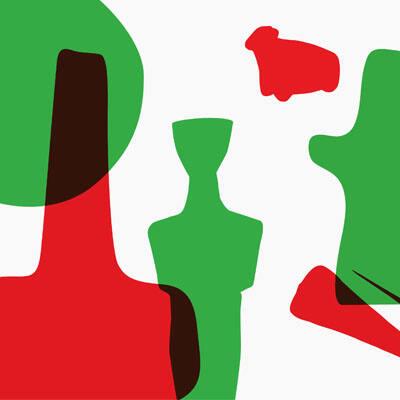Figurine
Clay figurines
Χρονολόγηση1400-1200 π.Χ.
Date
1400-1200 BC
MediumΛεπτόκοκκος καστανός ανοιχτός πηλός
Medium
Fine-grained light brown clay
Dimensions10.5εκ. × 5.3εκ.
Dimensions
10.5 cm
ClassificationΠήλινα
Classification
Ceramics / Figurines
Αριθμός ΑντικειμένουΚΠ0010
Object Number
ΚΠ0010
ΠερίοδοςΎστερη Εποχή του Χαλκού
Period
ΠεριγραφήΜυκηναϊκό σχηματικό ειδώλιο τύπου Ψ. Πρόκειται για όρθια γυναικεία
μορφή, με πτηνόμορφο πρόσωπο (με μορφή πτηνού), ανάγλυφα στήθη, και ανυψωμένα
χέρια σαν πτερύγια σε στάση δέησης. Φορά ψηλό κάλυμμα κεφαλιού (πόλος) και
φόρεμα που καλύπτει τους σχηματικούς βραχίονες. Οι λεπτομέρειες του ενδύματος
δηλώνονται με διαγώνιες και κάθετες καστανοκόκκινες γραμμές.Late Bronze Age
Description
DescriptionThis schematic female figurine of Psi-type has a bird-shaped face, the
breasts are plastically rendered, whereas the raised arms resemble wings in a
gesture of supplication. It bears a tall headdress ("polos") and
wears a garment which covers the stylized arms. The figurine is decorated with
vertical and horizontal brown-red lines which represent the garment details.
The two figurines depict standing female figures with folded hands on one of them and the other raised in an attitude of supplication. They have been called conventionally "Phi-type" and "Psi-type" because of their resemblance to the two letters of the Greek alphabet (Φ, Ψ). Their garments, jewelry and details on the face have been rendered in painted decoration.
The first figurines of the "Phi-type" and "Psi-type" were crafted in Mycenae around 1450 BC and are typically discovered in shrines, homes, and tombs. The "Psi" figurines depict women in prayer, while the "Phi" figurines depict women holding a baby."
Τα δύο ειδώλια απεικονίζουν όρθιες γυναικείες μορφές. Το ένα έχει διπλωμένα χέρια και το άλλο έχει τα χέρια σηκωμένα προς τα πάνω, σε στάση προσευχής. Τα έχουν ονομάσει ειδώλια «Φ και Ψ», λόγω της ομοιότητάς τους με τα δύο γράμματα του αλφαβήτου. Οι λεπτομέρειες στο πρόσωπο, τα ενδύματα και τα κοσμήματα είναι ζωγραφισμένα. Τα πρώτα ειδώλια «Φ και Ψ» κατασκευάστηκαν στις Μυκήνες γύρω στο 1450 π.Χ. και έχουν βρεθεί σε ιερά, σε σπίτια, αλλά και σε τάφους. Τα ειδώλια που μοιάζουν με το γράμμα Ψ απεικονίζουν γυναίκες που προσεύχονται, ενώ τα ειδώλια «τύπου Φ» γυναίκες που πολλές φορές κρατάνε ένα μωρό.
These clay standing female figurines with arms folded or raised in an
attitude of supplication are the commonest types of Mycenaean figurines. They
are small in size, handmade and are called conventionally Phi-type, or Psi-type figurines, for their
resemblance in shape to those Greek letters (Φ and Ψ). Their garments and
jewellery are indicated by painted decoration, while the breasts and the
headdress are modelled. Often, they wear a “polos”, a tall headdress associated
with divinities, and a necklace. Mycenaean female figurines are found
frequently in shrines, graves and even houses. Their symbolism was complex and
their use probably varied according to the circumstances. In general, they are
thought to represent goddesses possibly associated with fertility. As, however,
such figurines are frequently found in children’s graves, it is possible that
they were also used as toys. Mycenaean figurines made their appearance at the
end of the 15th c. BC and continued to be used until the end of the 12th c. BC.
Their origins should be sought in the Minoan tradition since figurines are
totally absent from the Greek Mainland during the preceding Middle Helladic
(2000-1600 BC) and early Late Helladic periods (16th-15th c. BC). Nonetheless,
they soon achieved a high degree of stylistic uniformity and began to be used
widely all over the Mycenaean world.
Οι όρθιες γυναικείες μορφές, με χέρια διπλωμένα ή υψωμένα σε στάση δέησης, αποτελούν τους συνηθέστερους τύπους μυκηναϊκών ειδωλίων. Είναι χειροποίητα και αποκαλούνται «τύπου Φ και Ψ» λόγω της ομοιότητας τους με τα αντίστοιχα γράμματα της αλφαβήτου. Με γραπτή διακόσμηση αποδίδεται η ενδυμασία τους και τα κοσμήματα, ενώ με πλαστικό τρόπο αποδίδεται το στήθος και το κάλυμμα της κεφαλής. Ειδώλια αυτού του τύπου ανευρίσκονται συχνά σε ιερά, οικίες και τάφους και είχαν τον ρόλο λατρευτικών αφιερωμάτων. Ο συμβολισμός τους ήταν σύνθετος και η χρήση τους ποίκιλε ανάλογα με την περίπτωση. Τα ανθρωπόμορφα ειδώλια, όπου κυριαρχεί η γυναικεία μορφή, απεικόνιζαν μάλλον θεότητες, ενώ δεν αποκλείεται να χρησίμευαν απλώς ως παιχνίδια καθώς ανευρίσκονται συχνά σε παιδικούς τάφους. Τα μυκηναϊκά ειδώλια αρχίζουν να κατασκευάζονται στα τέλη του 15ου αι. π.Χ. και συνεχίζουν να χρησιμοποιούνται μέχρι τα τέλη του 12ου αι. π.Χ. Η καταγωγή τους θα πρέπει να αναζητηθεί στη μινωική παράδοση, καθώς κατά την προηγούμενη Μεσοελλαδική (2000 - 1600 π.Χ.) και πρώιμη Υστεροελλαδική περίοδο (16ος - 15ος αι. π.Χ.) τα ειδώλια απουσιάζουν εντελώς από την ηπειρωτική Ελλάδα. Σύντομα πάντως, επιτυγχάνεται υψηλός βαθμός τυποποίησης και τα μυκηναϊκά ειδώλια αρχίζουν να χρησιμοποιούνται σε κάθε γωνιά του μυκηναϊκού κόσμου.













